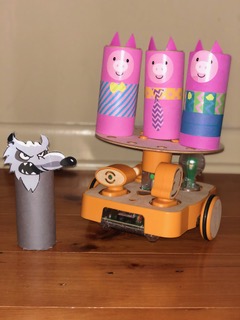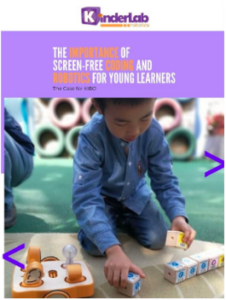Integrating Reading and Writing into Screen-free Robotics
We all know that reading, writing and creativity are vital to innovations in science and technology. The STEAM education movement takes the best of STEM – Science, Technology, Engineering, Mathematics, and adds the important elements of the Arts – but where does that leave the reading and writing?

STEAM curriculum programs and the introduction of coding robots in the classroom is about connecting the dots, integrating disciplines, and valuing creativity and innovation. It does this with a focus on the essentials of problem solving, critical thinking, collaboration and innovation and combining them with technology skills. However, in order for students to learn by seeing the full picture, not just parts and pieces, the element of reading and writing must be incorporated to engage in deeper learning and analysis.
Screen-free programming robots such as KIBO require students to create, design and decorate their own robots to do tasks that they code them to do and to blend together the best of science, art and technology. Integrating these elementary education coding robots as part of STEAM education is a way to encourage play in the classroom for early learners. Children learn by using their imaginations, by building something from the ground up, and by being aware of the connections that exist between subjects and areas of learning. In recent years, the amount of time children spend in front of “screens” has been cause for much debate. By eliminating the screen aspect of coding in schools, students have a wider array of potential for tapping into their imagination with constructive play. They can use wooden building blocks to code, to create sequences, and to design a robot that might help them with a project on animal migration, earth science or local geography.
Reading Comprehension and Writing Workshops with KIBO
Screen-free robotics, when integrated into a STEAM learning curriculum, appeal to young kids who love arts and culture, who love physical activity, and who are tech or science minded in pre-K to 5th grade. There are numerous ways to use coding robots, such as KIBO, to engage a student’s interest and foster a love of learning. While some concepts are more easily integrated than others, the idea of reading and writing with robots is nothing new to the curriculum. In fact, it’s a creative and enjoyable aspect of learning that students look forward to. For example, early learners read a story. KIBO is then used to add an interactive portion to the learning by having kids decorate the robot and then code the robot to perform an aspect of the text that was just read. That same lesson can translate to writing workshops. Students are asked to create their own stories and then code KIBO to “act out” portions of the tale. This elevated the level of learning as students are able to get a hands-on, more tangible understanding of the readings.
Introducing programming with coding robots helps to develop the tools children need to nurture their inner engineer, designer, programmer, artist, or writer. STEAM is about collaboration, integration, and bridging the gaps between academic disciplines and ways of thinking. It’s focus on critical thinking, writing, reading, and the use of the arts, as well as science, math, and technology provides an in for students with aptitudes encompassing all areas of academia. It has something for everyone, and it provides the challenges that early learners need to grow and develop. Schools implementing STEAM education curriculum with screen-free robotics in creative and successful way builds confidence and a love for learning.
Meet KIBO, a Screen-free Educational STEAM Robot
There are coding toys available designed to approach a precise issue: How do we teach young people about coding fundamentals while giving them a fertile environment for other aspects of their growth? Enter KIBO, a screen-less way to engage and learn. Using programmable wooden building blocks that can be placed and manipulated to create sequences that will direct a robot’s movements, it addresses a growing understanding of technology’s impact on childhood development and allowing us to rethink the amount of time children interface with computers.
KIBO, the learning robot designed specifically for kids, offers an inviting, engaging platform for young children to start their journey into creating with code in a fun and creative way. KIBO’s block-based coding language gives children control over the robot’s movements, sounds, and sensors, allowing them to express their imaginations with code. The KIBO curriculum for educators also teaches children to tell stories, create characters, and explore the world around them through code. KIBO is the number one choice in screen-free coding for kids – trusted by more parents and schools to introduce today’s youth to the wonders of technology and robotics.
Learn the 6 Key Benefits of Using Robotics with Your Youngest Students!
![]() Introduce coding and robotics into your early childhood classrooms – in a fun and playful way!
Introduce coding and robotics into your early childhood classrooms – in a fun and playful way!



















